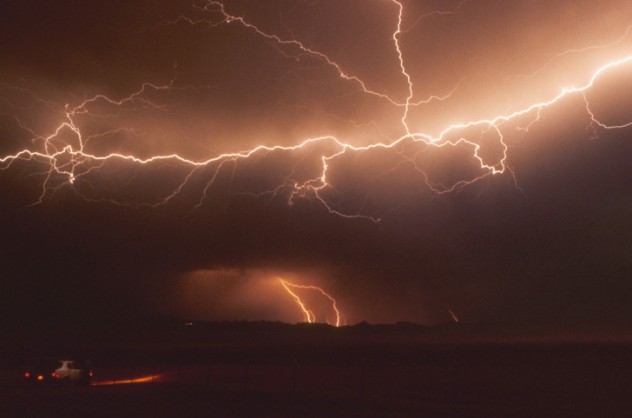

Heat lightning is just regular lightning caused by a distant thunderstorm. Thirteen seconds would equal 2.6 miles, and 19 seconds would be 3.8 miles. PREFACE BY PATRICIA MCCLELLAND MILLER 352pp. Heat lightning is an unofficial term used to describe what people perceive as lightning produced without thunder. Thus for every 5 seconds delay between seeing lightning and hearing thunder equals 1 mile in distance. Lightning moves at 186,000 feet per second - essentially instantaneous on Earth's surface - while sound waves move at about 760 miles per hour. Under normal circumstances, though, you can calculate the rough distance you from a lightning strike by counting the delay between seeing the lightning and hearing the thunder.

LIGHTNING SAFETY: WHEN THUNDER ROARS, EVEN TAKING OUT THE TRASH CAN TURN DEADLY On the other hand, lightning strikes have been known to travel as far as 25 miles from their parent thunderstorm, so there is danger in being struck by lightning "from the blue" without having any thunder cues that a storm is close or approaching. The exact distance depends on the temperature and density of the air, but generally speaking, thunder can go about 10 miles before it dissipates to near inaudible levels. (The sound of thunder rarely carries more than 15 miles.) Heat or sheet lightning usually doesnt bring rain immediately, but it indicates that unsettled. But sound waves can only travel so far before they're scattered out by air molecules. Use the form below to sign up for the Pinpoint Weather Insider newsletter, sent every Thursday.Lightning is bright enough it can be seen from any distance across the horizon - even dozens of miles away if the horizon is flat enough and the storms are tall enough. It’s just the same old lightning, but so far away you can’t hear the thunder. As the storms push way off into the sea as night falls, you’ll likely see the lightning way off in the distance, but hear no thunder. You will notice this a lot as our daily and highly-electrified sea breeze storms get going. Typically, the sound of thunder only travels approximately ten miles. The term heat lightning is commonly used to describe lightning from a distant thunderstorm just too far away to see the actual cloud-to-ground flash or to hear the accompanying thunder. Though infrequent, bolts from the blue have been known to strike areas as distant as 10 miles from their thunderstorm origins, where the skies appear clear. Fact: Lightning often strikes more than three miles from the thunderstorm, far outside the rain or even the thunderstorm cloud. It’s called heat lightning because some people think that the heat is creating those lightning strikes. Acknowledgements Heat Lightning was written in cooperation with my old. The actual phenomenon that is sometimes called heat lightning is simply cloud-to-ground lightning that occurs very far away, with thunder that dissipates before.

The observer is simply too far away to hear the thunder associated with the lightning. Myth 4 If you don't see rain or clouds, you're safe. They got another flickering flash off to the west. The light is then reflected off of higher-level clouds allowing it to be seen from great distances. In reality, it is just light produced by a distant thunderstorm. Many people incorrectly believe that heat lightning is a specific type of lightning. This is commonly referred to as heat lightning, but it’s not really a thing.

However, if the storm is moving in your direction and. You’re sitting on your porch on a warm summer night and off in the distance you see a flash of lightning, but you hear no thunder. As for being struck by heat lightning, the odds are very low so long as it remains too far away to see the lightning path and hear thunder.


 0 kommentar(er)
0 kommentar(er)
